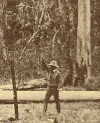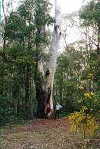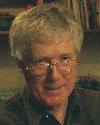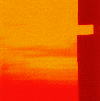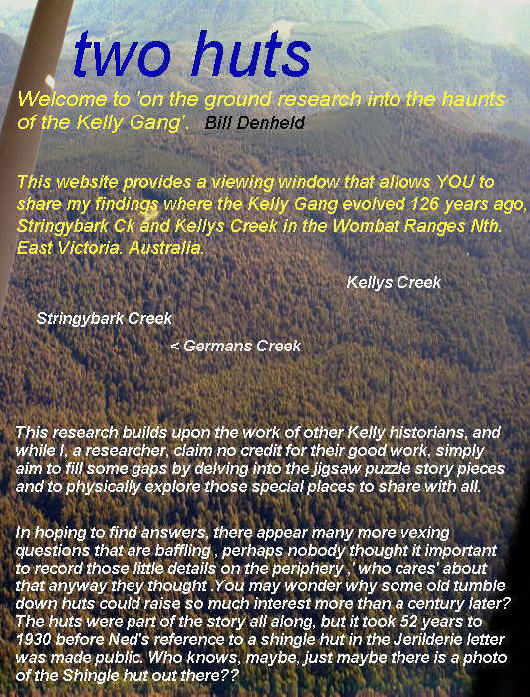
Introduction
Two huts at Stringybark Creek.
Two bush hut fireplaces
found at Stringybark Ck by
Kelly researcher and the writer Bill Denheld, help to re-establish the
exact location where three police were killed by the Kelly gang in October
1878. Old fireplaces found, are all that remain of two huts that are
important to the Kelly story as one is certainly that of
the shingle hut
that Ned Kelly referred to in his
Jerilderie letter dated 1879.
 |
The shingle hut’ as written in Ned Kelly’s Jerilderie letter of 1879 by his mate Joe Byrne. |
The Jerilderie Letter is a treasured document held by the State Library of Victoria that was hoped by 'Ned' to explain to the 'Crown', the injustices endured by the Kelly family. It tells how, in self defense three police were shot. Intended to be published while the gang was on the run, the 7500 word autobiography and makings of a rebel manifesto to proclaim North Eastern Victoria a republic was withheld by the authorities and not made public until 1930. The original 56 page hand written letter was accepted by SLoV after 32 years of offerings by Mr. Keith Harrison and Mr. Ian Jones in November 2000.
 |
Bill at the remains of an old rock
fireplace that may prove to be that of the shingle hut. |
|
 |
 |
|
This website covers many historical
facts and items of interest to do with Stringybark and Kelly's
Creek. The
Kelly tree
from the earliest photo to the present
day. A letter referring to
Blue Range
that may be why the police went to
Stringybark Creek- dated eight days before three police were killed there.
How a postcard produced
by photographer Burman,
taken at the fatal police camp was used at
Ned Kelly's preliminary trial that differs from survivor- Const.
McIntyre's
sketch and lead to confusion for the
magistrate. See how details in the photos enabled an accurate birds eye
view reconstruction of the scene. How forensic investigation of the photos
lead to the finding of the two fireplaces. Read what McIntyre later told
the Royal Commission in 1881. We can wonder
what was the motivation for the man hunt, the rewards offered for Kellys
capture, or justice?
The story of Ned Kelly and the Kelly Gang is firmly placed in the history
of Australia. In some quarters Ned Kelly has achieved folk hero status and
the exploits of the Kelly Gang are increasingly attracting world
attention. A crucial episode in the Kelly story was the shoot out at
Stringybark Ck which resulted in the deaths of three policeman. The exact
location of the site of the shoot-out has been in doubt as a definitive
marker, the so called ‘Kelly tree,’ was reportedly cut down by saw millers
in 1908.
Since then, with the loss of the Kelly tree and the passing of generations
of local knowledge, the location of the police camp site faded into
obscurity.
 Relationship of the two huts to each other according to the fireplaces |
However, documentary evidence remains, in photos, maps and written statements, and this evidence has been utilized over the years in attempts to pin point the site. One feature of this evidence which had not previously been fully explored is the proximity of the police camp site to ‘two small huts’, one of which could have been ‘the shingle hut’ written about by Ned Kelly in his ‘Jerilderie letter’ of 1879. The Kelly’s knew the area well and when Ned Kelly refers to ‘the shingle hut’ (at Stringybark Ck) in 1879, -he must have referred to a well established building of a particular style that had been there for some time. The evidence to support this comes from three sources. One is in a pamphlet published by news paper owner in 1879, G. Wilson Hall: called ‘The Outlaws of the Wombat ranges’, on page 24 that states (referring to the police camp at camp at Stringybark Ck)- as follows, |
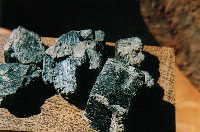 Charcoal from Hut1 fireplace |
|
The
2nd source,
'The
Argus’
news paper article dated Monday, October 28th 1878, just two
days after the Killings, reported that
'
the
police camped from Friday evening at Stringybark on an open space
on a creek - the site of some old diggings - and they pitched the tent
near the ruins of two huts'.
3rd source,
' The Complete Inner
History of the Kelly Gang and their Pursuers'
by
J.J. Kenneally 1929. J.J.K had 'Tom Lloyd', cousin of Ned as
his guide when preparing to write his book. References to
the shingle hut
by
J.J.K claims the shingle hut as standing at the time of the shoot out.
He wrote, Sgnt Kennedy had been shown the place to camp by Mr. Tolmie,
and showed him
the shingled
hut on Stringybark Creek, near where the police party afterwards pitched
their tent. Then it reads on
- that Ned had deputed brother Dan to investigate a shot fired, - heard at
the Kelly camp over the hill, Dan
reported that the police were at the shingled hut on Stringybark Ck, and
that their tent was pitched in the open space nearby.
J.J.K. also writes on
page 52, after shooting Lonigan dead,
Ned Kelly then called out, asking McIntyre who was in the hut. The later
replied. " No one"
He clearly states hut not
tent,
In Max Brown's version Australian Son (1947) page 68, Ned to
McIntyre " where is your revolver?" he asked " at
the tent" "Who's in there?" " No one" he replies.
Max's book was written 69 years after, where as J.J.K's written
50 years after the event. But, since J.J.K's was partially written by Tom
Lloyd himself, and the fact it was Tom's wish the book not be published
till after his death in 1928, I like to believe Tom would not have
mistaken a hut for a tent. Max Brown also had descendents to guide him
through the finer points of the story when referring to the revolver at
the tent. Somehow unfortunately the story becomes blurred.
What is entirely possible, that the police did in fact make use of the hut
on the other side of the creek if the police had made their camp on the
Eastern Bank of the creek? Ned may have noticed something about the
hut to suggest the police were using it considering there were four
troopers camped here during what could still be a cold and wet October.
One wonders how all four would fit into an 8 x 10 foot tent with all those
provisions for a possible two weeks exercise? Perhaps the hut was being
used to dry out cloths?
UPDATE: The general agreement amongst historians is that the
police camp was on the eastern bank of the creek, and as later day Kelly
researchers do their own research, it is easy to
accept what has gone on before. However, since 2009, the western
bank of Stringybark creek at the two huts site rings all the bells for the
true police camp because all
historical evidence points to that. A collective study has been underway
and the results will be announced here and on the ironicon webpages.
Click here.
The
Mansfield Guardian
reported in Aug 1877, a court case of the deliberate burning of Percy
Bromfield’s hut by his prospecting partner Walter Lynch. ** My view is, - this hut
burning related to a more recently built ‘ third ’ hut perhaps using the
old fireplace of one of the other two
huts
- as seen the remains of a charred corner post that
survived that hut burning fire (indicating green wood) maybe be seen in
the post card below.
 This photo
of the police camp site taken by photographer C.F. Burman Oct 1878 is the
location we are looking for. Stringybark Creek runs North South and is about 2 km
long. This site (in the photo) is either on the east bank or west side of
the creek.
This photo
of the police camp site taken by photographer C.F. Burman Oct 1878 is the
location we are looking for. Stringybark Creek runs North South and is about 2 km
long. This site (in the photo) is either on the east bank or west side of
the creek.
The two fireplaces found are on the west bank.
Note: Two burnt posts in the ground would not constitute a hut to be marked on
a map, except where one once stood.
Image Citation PROV
Burman photo -0030-010-001- VPRS 4966
Consignment P0 Unit 2 Item 30 Record 1 Document: Photo of Wombat Ranges
where troopers were shot.
We have a court note verifying F C Burman took the photo,
Re -- Kelly, Fredrick C Burman Photographer Bourke St, (- ? -) The
photo produced is a picture of the ground where Constable Lonigan +
Scanlon were shot I took it myself - The place was pointed out to me a few
days after the murders by Mr Monk - the spear grass in the neighbour hood
is about 6 to 7 foot high. Note Monk was with McIntyre when the
bodies of Lonigan + Scanlon were found - McIntyre identifies the photo: +
draws attention to an upright post the remains of an old hut, to right
hand corner of picture
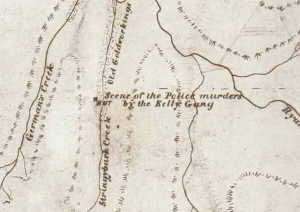
This 1884 map of the area shows a hut site with the script,
-
" Scene of the
Police Murders by the Kelly Gang".
In the Jerilderie letter Ned Kelly
himself said the police were
camped at the Shingled hut.
Land Selection Files and Correspondence
Files: Public Record Office of Victoria (PROV) VPRS: 626/P Unit 650,
File 19725/19.20:
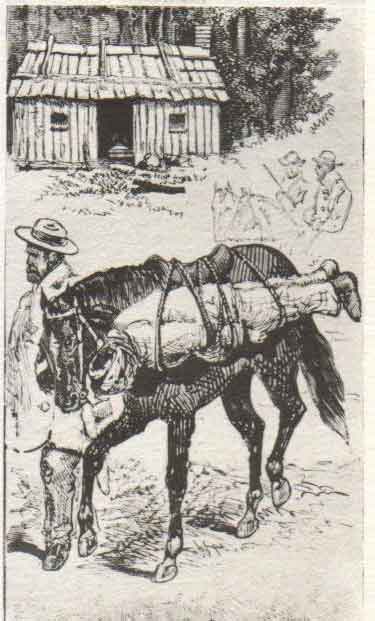 Pictured
Left, ascribed as 'The
Bushrangers
hut at Glenmore Ranges' - meaning by the article
featured in the
The
Australasian Sketcher Nov 1878,
'Ned Kelly’s hut at Stringybark Creek'.
Pictured
Left, ascribed as 'The
Bushrangers
hut at Glenmore Ranges' - meaning by the article
featured in the
The
Australasian Sketcher Nov 1878,
'Ned Kelly’s hut at Stringybark Creek'.
I say this because the whole article is about Ned Kelly killing the three
police troopers. If the reporter shows a hut described as the bushrangers
hut at this location, then this hut must have been standing at the time.
The foreground image shows the two bodies of the dead policemen
being carried out on pack horse -
as suggested from the remote location in the Wombat Ranges to Mansfield.
But the caption reads - Bringing in the bodies of ----------------- not
readable. The drawings are a montage of the tragic events as featured in
The illustrated newspaper Australasian Sketcher.
Queensland historian Kelly researcher Greg Young who
alerted me to the image, and we have concluded the Hut shown could
well be ‘The Shingle Hut', one of two ruined huts as mentioned in the
press at the time as where the police had camped, and believe this is the
only know image of the hut at Stringybark Creek.
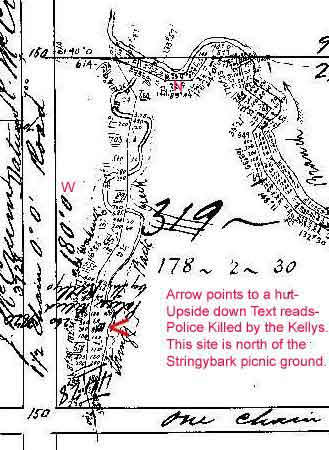
Also,
Sheila Hutchinson and Fay Johnson's research webpage shows a 1885 map with
a hut on the west bank, and although the surveyor does ascribes that hut
to the site " Police Killed by the Kellys" ,
on the Western Bank, the hut site is 360 metres further North from
the accepted police camp site at the two huts site. However, we can be
sure as history tell us the site where the police were killed by the Kellys is associated with a hut that was standing at the time.
But the hut on this 1885 map could not have been built at the
time the shootings that took place in Oct 1878,
This hut marked was was either the abode of the first land owner James McCrum.
This image courtesy Sheila Hutchinson and Fay Johnson's Valid Links with
the Past, webpage with permission from The Public Records office-
LandSelectionFiles:VPRS: 626/P Unit 645,
File 19279/19.20:
With the recent finding of two huts fireplaces opposite an area already considered to be the site of the police camp (as opposed to the site near the Kelly tree picnic ground), we simply have to believe, that the fireplace remains are those of the two huts described by G.W.Hall and may complete a sixty year old mystery of the exact location of the police camp and that one of the fireplaces was the Shingle Hut.
 Fireplace hut 1 approximately 12 metres away from |
 Fireplace hut 2. Note, large but hardly noticeable. |
Six months after
finding the fireplaces a small group of historians examined the two huts
fireplaces and decided to re- metal detect any easy detectable items
prior to covering with mesh. Dave White who was author of a series of
Kelly related articles on webpage
www.ironoutlaw.com - 'The White Stuff ' and after
visiting the site was convinced the two huts were related to where the
police had camped and where Constable Lonigan and Scanlan were shot
dead.
Read Dave White's report-
Click on image to enlarge-

Footnote to this above article reads:
This article by Dave White was hosted by Brad Webb on Iron Outlaw web
page in March 2003. At the time I had printed Dave’s report and filed it
away to be lost. A short time later I noticed Dave’s article was no
longer on line and learnt it had been deleted due largely to the
grumblings of Kelly guru Ian Jones ! Only recently I found my
original print out so I post it here for all to read. The two items
found by Dave as pictured are in his possession and he had assured me
they would be made available for show if and when ALL the two huts items
were to be brought together for display at a Ned Kelly Centre. They were
offered to The Ned Kelly Vault in Beechworth but were rejected as junk.
Perhaps someone who has a digital copy of Iron Outlaw - on disc which
included 'The
White Stuff'
could provide this page with better
images. Thanks Dave for your report. Bill
This following series of articles report on these findings, as well as the history of the Kelly tree, - 'Why the police went to Stringybark Ck', or how the Kellys knew the police were there and also an analysis comparing Constable McIntyre’s sketch to the Burman photographs.
 As
early as the 1940’s Kelly historians had problems visualizing the present
day Kelly tree in its surroundings on the western bank of Stringybark
Creek ‘as the site of the shoot-out’. The Kelly tree (left) was marked in
1933/4 and it is the third tree in a line of succession , each time a
little further away from the original position. This picture is looking
south east with the Creek to the left. Even though there are display
amenities at Stringybark Ck,
I wondered for how many more years visitors would come here only to be
faced with a deception of a Kelly tree that could be 3-400 meters away
from where it should have been.
As
early as the 1940’s Kelly historians had problems visualizing the present
day Kelly tree in its surroundings on the western bank of Stringybark
Creek ‘as the site of the shoot-out’. The Kelly tree (left) was marked in
1933/4 and it is the third tree in a line of succession , each time a
little further away from the original position. This picture is looking
south east with the Creek to the left. Even though there are display
amenities at Stringybark Ck,
I wondered for how many more years visitors would come here only to be
faced with a deception of a Kelly tree that could be 3-400 meters away
from where it should have been.
I felt compelled to try and solve the mystery and find the correct location of the police camp and the Kelly tree, not expecting to find the shingle hut site as well.
A very interesting publication that summarizes all the known facts on
Stringybark Ck is included in the Ned Kelly Seminar Papers. At the Ned
Kelly seminar held in Beechworth in 1993 which the papers report,
historian Ian Jones read his chapter, The Killings at
Stringybark Creek: New evidence from a Surviving witness,
in which he identified the most likely area of the Police camp and its
proximity to one or two huts.
( A copy is available, see publications for details.)
Renowned Kelly historian Gary Dean informs me that during the 1960’s to
70’s, any person making inquiries at the Mansfield Shire Offices as to the
site of the police shootings, was given a map which showed clearly that
the site was on the east side of Stringybark Creek, but just where, was
left up to your imagination?
Ian Jones's definitive paper of 1993 concludes that the gunfight
had occurred further up the creek from the present day Kelly tree and on
the Eastern bank. Ian Jones 'states'
in the paper he made this conclusion after tending to disbelieving local
knowledge offered to him some thirty years before ' that the police camp'
was up the creek on the eastern bank of Stringybark.
The problem was, a
‘hut’ site adjoining the 'current considered police camp site' had
not been found.
In the Kelly seminar, Ian Jones spoke
".It
seems most likely that the remains of the marked hut on the western bank
were taken eventually as marking the site of the police camp “
Interestingly, when the fireplaces of two huts were found Sept 2002, Ian
Jones was notified and invited to be taken there and view them on several
occasions, but he never responded except on public ABC radio 774AM four
months later when on radio he was questioned about the found fireplaces -
and he
described the findings as 'Codswollup'.
Why would he say this ?
During 2003 when Ian Jones re launches his second edition of his book, A
short life,
he made references to the fireplaces found, and makes a note on page 385/6
- that reads - quote
”Despite
an extremely misleading report in The Age, 10.2.2003 ‘ New find
leaves shooting theory up the creek’ , the discovery of two fireplaces
nearby, on the western bank of the creek, does nothing to refute my
identification of the site, and in fact throws no new light on the
subject. Numerous huts were build in the vicinity, before and after 1878.
Like some other recent ‘discoveries’, this one seems more concerned with
publicity than historical insight "
Then in his
latest 2008 edition in a similar vein - on page 443 in notes
Quote
“ Two fireplaces, on the Western bank of Stringybark
Creek opposite the Gunfight site, have been given inappropriate
significance since 2003. ( see Age 10/2/03 ) No contemporary source refers
to them. A second ruined hut mentioned by G Wilson Hall in 1879 (
Mansfield Pamphlet, P24) some distance to the north of the site, was
identified in 2006 by Dave Wilson and Dave Brown.
( Dave Wilson should be Dave
White)
But this statement is completely erroneous and misleading - as from all
historical records there is no
mention of the huts being separated by any distance or North of the site.
He also
states that with his son Darren after doing lengthy orientation field work
looking for the police camp in October 1993
he
" identified the site
several hundred metres south of the accepted location marked by 'the Kelly
tree' and on the opposite, eastern bank of the creek".
Readers are led to believe he actually identified the site of the
police camp after doing lengthy orientation fieldwork .
Yet in his seminar talk he said the following, as transcribed from an audiotape
recorded at the time but many years later by Marrian
Matta whom I met and we shared all her splendid typing at a website on
www.ironicon.com.au
A transcribed paragraph- Ian Jones speaks-
” We had arrived at the area pointed out to me by Jack Healy nearly
thirty three years before and rejected by me because of my stubborn
conviction that the site was on the opposite bank of the creek ---Careless
reading of sources, particularly Kenneally, and mental inflexibility
doomed me to thirty years of chasing my tail where the site of Stringybark
Creek was concerned.-- --- -- -- --- It may be too early to say that we have located
the actual site of the Stringybark Creek gun battle. However
we can say with complete confidence that perhaps for fifty years people
have been honouring a spurious landmark”.
( the 1930s Kelly tree at SBC)
Ian Jones, during his talk at the Ned Kelly Seminar in 1993, clearly states how important it is to find the remains of
a hut to verify the true police camp location, so we can assume he never
saw the fireplaces, but when a fireplace of a hut is found right opposite
his considered
police camp on the other side of the creek, he publicly pronounces these findings as 'Codswollup'.
Then in his 2003 edition of his 'Ned Kelly- A short life', he publicly vilifies
the findings, yet goes on to describe how he
identifies the true location of the police camp while all along he had
been shown where it actually was by an earlier generation land owner - Jack Healy,
who had his farm just half KM to the west.
Please read this carefully-
According to Ian Jones's 1993 statement above;
1) 'Jack Healy' had taken Ian to the site he had been shown to be the
true location- 'nearly thirty years before' in 1963 but
Ian Jones admits his careless reading of Kenneally's 1929 book- 'The
Inner History of the Kelly Gang, and that
his mental inflexibility doomed him to thirty years of chasing his tail,
and his stubborn conviction was that the true site was on the opposite side
of the creek from the Kelly tree and where Jack Healy had taken him, and this led Jones to
decide the police camp was on the East bank of the creek adjacent to
where Jack had shown. Because Jack was a close by local he would have
been keen to know.
2) This means Jack Healy had
shown Ian Jones the west bank two hut site, but Jones rejected that site
on the basis of what he had read in the Inner History book. While Jones
was there with Healy, neither may have noticed the remains of the fireplaces
because during that time the thick scrub and ferns made them non
visible.
3) In Sept 2002 I stumbled upon the fireplace rocks of one hut while
there with Gary Dean, and he confirmed the C shape pile of rocks had
been the fireplace of a hut. We spent an hour there scratching around in
the dirt, and even then we did not see the second fireplace which was
only 30 feet away.
4) It is interesting to note that some locals of the 1930s- 40s
had not known of those fireplaces.
One was Sheila Hutchinson (nee
Brond) and
neither her father Tim Brond, because otherwise Tim would not have gone
to the trouble and axe and scarf the big tree on Charlie Beasley's
property some 300 m downstream, as the Police tree, not the Kelly tree.
In early 2003 Sheila told me she had never seen nor known of the
fireplaces in her younger days.
5) Another local, Charlie Engelke, said when he was just a young lad and would walk
up and down SBC road
everyday as their farmhouse was at the top of SBC. Charlie told me he
would have passed the spot a thousand times and yet had never seen the fireplaces of the two
huts. (Letters; dated Apr 2003)
It's interesting to note that Jack Healy only one year after showing
Ian Jones the site, was interviewed by the Woman's Day magazine 6th
April 1964. Jack Healy as quoted here,- " I'll show
you the spot where the killing happened," said Mr Healy. "It's hard to
find. But I came to this district in 1922 and can remember seeing the
stump of the white gum tree where police were camped when the shooting
started." -- -- -- " Tourists who come to this district would never find the
place. And a misleading signpost leads them to "Kelly Tree," a huge
white gum, near Stringybark Creek, blazed with the words, "1878 Kelly
shot Lonigan."
But here is the point, the current (third) Kelly tree
had been marked during 1933/4, and that is easy to find, and he
says the true site "It's hard to find"
.
By finding of the fireplaces of two huts at SBC was to confirm
and add proof as to where the 1878 police party had
camped -and where Constable Lonigan was shot, and just down the bridle
track about 30 m away Cons Scanlan was
also shot dead. The two huts site should be the prime reason to visit SBC
to see, not the misleading storyboards leading the visitor up the garden
path where nothing ever happened. Shame on the authorities for telling
such
BS.
During 2004, with
co-operation from the Department of Sustainability and Environment ( DSE )
and numerous other historians, they all agree the fireplaces would be given
recognition and an
archeological dig investigation. The DSE historian Mr. Daniel
Catrice said that while the fireplaces in themselves were not a
significant structure, he acknowledged they were very important to the
Kelly story and had to be preserved. I decided to do this myself, but they covered
them with mesh in 2004
and I nominated the whole Stringy Bark Creek area for heritage
listing the same year.
On 13 May 2008, four years to the day it was
announced in the news by Jeremy Smith, 'Heritage Victoria' head archaeologist -
that the
three creeks at Stringy Bark are to be heritage listed on
Victorian
Heritage inventory.
Regarding signage at SBC, the DSE decided to be guided not by the Mansfield
Historical Society, of which I was a member , but rather by the 'Ned
Kelly Touring Route' planning committee to which Ian Jones happens to
be their historical consultant.
However, with the launch of the Ned Kelly Touring Route well underway,
many more thousands of people would be expected to come to visit this place. It is 'shameful ' the prospective visitor, once he/she arrives is still kept in
the dark by the deception of the current Kelly tree with no
other signage to direct the visitor to the real site.
As of
Dec 2008
After 5 years this webpage has been lobbying for signage to direct
visitors to the true location as opposed to the general Kelly tree location,
i.e. The police camp at two huts location, the DSE had drawn up
plans for a walking track to the police camp following the Eastern Bank
track as part of the Stringy
Bark Creek re
- development program, but without any reference to the
two huts fireplaces on the western bank. -
This would be because my and others research was not considered to be part of the
'Stringy Bark Reference Group' due to one person - ' Ian Jones'. They have embarked on spending
$50k of public monies on mis guided historical facts and I
being excluded from the process, who would have required the
authorities to re think their tourism strategies.
On questioning DSE, they say the two fireplaces are not on the agenda
until further
archaeological investigation has been completed by Heritage Victoria.
Well, that's fair enough as we would not want the public to get in the way
of any dig there...... but they do not seem to respect the views of other
historians except those of Jones, and, if they never get around to
doing the archaeological investigation on the two huts site, then an
important slice of Kelly history will be forgotten because of one person
who did
not want the new findings to conflict with his published books.
As there is no signage planned pointing to the two huts, I
see no reason why the main notice boards could not make mention of this
researched
website where visitors could learn the full story once they were back at home, just like you
are reading this!
They have refused my request for this website URL to be included
on any of the notice boards, but they have included Ian Jones' book promotions.
Lets hope the public will see through this blatant cronyism, ill founded
on deception and not underpinned by historical truth.
It is interesting to note that Ian Jones in his re-release of his Ned
Kelly a Short life book 2008, still does not concede the importance of the
finding the
two fireplaces at Stringy Bark Creek.
As before quoted in his latest 2008 Ned Kelly book A Short Life he
writes in his notes pages 443 on Stringybark Ck-
quote
-
" Two fireplaces, on the Western bank of Stringybark Creek opposite the
Gunfight site, have been given in appropriate significance since 2003 (
see Age 10/2/03). No contemporary source refers to them. A
second ruined hut mentioned by G Wilson Hall in 1879 ( Mansfield
Pamphlet, P24) some distance to the north of the site, was identified in
2006 by Dave Wilson and Dave Brown".
Firstly, for Jones to claim the
old rock fireplaces of two small huts near the police camp having
" No contemporary
source referring to them"
is ridiculous. He needs to re- read - G Wilson Hall's 1879 pamphlet - The
Outlaws of the Wombat Ranges page 24 -
“The spot where they established their halt, was a
small clearing on a rise alongside of the creek, near the ruins of two
small huts, one of which was burnt down, and had been the temporary
residence of three prospectors, named Reynolds, Bromfield and Lynch, who
worked the creek for a short time with indifferent success.”
Then Jones writes-
"
A second ruined hut mentioned by G Wilson Hall in 1879 - some distance to
the north of the site, was identified in 2006 by Dave Wilson
(White) & Dave Brown.”
What Dave White had come across
was small pile of rocks dumped just off the road where they had built
BBQs, several of which were still standing in the bush in 1985 when our
family stopped there to look at the Kelly tree.
In G.Wilson Hall's book he does not
mention a second ruined hut at all, he simply states the police camped
" near the ruins of two small huts",
and
the Argus of 28 October 1878 the police pitched their tent -
"near the ruins of two huts".
These two small huts pinpoint exactly where.
Ian Jones's new book Notes do nothing to bring clarity, - rather to
confuse the reader into believing that his printed version of events is
complete and correct - when clearly they are not.
If you would like a detailed map for visiting the
above places, please contact me via email with your full name and
postal address. to- bill at denheldid dot com (for anti spam, you will know what to
do)
Please enjoy the research. Bill Denheld Dec 2008
___________________________________________________________________
The abbreviated stories following are a quick overview. For a full, more
comprehensive look, click on the links below these for the full story.
Stories
overview,
Story 1 -
The Importance of the Huts at Stringybark Ck
 See
what
was found at one of the huts and read why they are important to the Kelly
story.. References to the huts occupants, Reynolds, Bromfield and Lynch
and the burning down of Bromfield's hut by Lynch during 1877, and
the remaining charred posts can be seen in the forensic police photos
taken just after the police killings by the Kellys.
See
what
was found at one of the huts and read why they are important to the Kelly
story.. References to the huts occupants, Reynolds, Bromfield and Lynch
and the burning down of Bromfield's hut by Lynch during 1877, and
the remaining charred posts can be seen in the forensic police photos
taken just after the police killings by the Kellys.
This article explores how one of the huts was constructed as well as items
dug up by historian Gary Dean from an adjoining rubbish dump. The dumped
items suggest domestic occupation of one of the huts at late 1880's and a
penny 1885 supports this. We believe further
archaeological work at the site, dating of early 1860's will be
confirmed.
For the full story on the importance
of the huts
<
click here >
Story 2 One hut or two ,

The first known map of the area was a gold field’s map. In 1884 the surveyor preparing the first map of the district marked ‘Hut’ on the western bank of Stringybark Ck. and directly opposite the hut, notes,‘Scene of the Police murders by the Kelly Gang’. In 1879, G. Wilson Hall wrote a pamphlet called ‘The outlaws of the wombat ranges’ in which he mentions that the police camp was near the ruins of two small huts, but one had burnt down, however the fireplaces remain. In this story, read references to huts at this location in various written articles of the time and attempts to find the evidence on the ground. Also I provide a birds eye view of the police camp in relationship to the huts. For the full story One hut or two, < click here >
Story 3 Orientation of
the Burman photo.
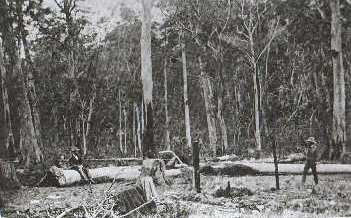 The
Burman photos were taken as a record of the murder scene. Not knowing
exactly from where they were taken; are we looking north, south east or
west? Going by the orientation of natural lighting on objects
throughout the photo, I observe that the main light comes from the right,
indicating a Northerly direction. In our Southern Hemisphere the Sun arcs
through the Northern sky. Photographs in 1878 required long exposure times and we can guess the photographer chose near midday to take the shots. In
summary from analysis of natural lighting we have been able to conclude
that the camera was pointing South West. This means the background details
in the photo are of the western bank of the creek. In this article we
provide evidence from shadow details to confirm this and show you both
Burman photos that lead to the fireplaces discovery.
The
Burman photos were taken as a record of the murder scene. Not knowing
exactly from where they were taken; are we looking north, south east or
west? Going by the orientation of natural lighting on objects
throughout the photo, I observe that the main light comes from the right,
indicating a Northerly direction. In our Southern Hemisphere the Sun arcs
through the Northern sky. Photographs in 1878 required long exposure times and we can guess the photographer chose near midday to take the shots. In
summary from analysis of natural lighting we have been able to conclude
that the camera was pointing South West. This means the background details
in the photo are of the western bank of the creek. In this article we
provide evidence from shadow details to confirm this and show you both
Burman photos that lead to the fireplaces discovery.
Then and Now.
After discovering the ‘fireplaces’ I made calculations to
plot the true location of the Police camp of 1878. A camera was set
up to capture the same area and a picture was taken of the scene 124 years
after the Burman photo.
For those interested, there is now a well defined walking track that goes
to the East bank site where there are two stone seats or a gateway
constructed. This was thought to be the entrance to the site defined by
Ian Jones and other locals (circa 1960's.) However we can now be certain
the true police camp site was on the Western Bank.
One option for the site
could be at the Two huts directly opposite the two stone seats on the
other side of the creek. The second site option is somewhere south of the
Kelly tree ( up and on the road) Below image right is the two huts site
which most resembles the first Burman photo, but is looking east rather
than south S westerly.
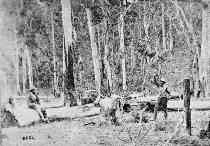 |
 |
Photo reproduced with the permission of the Keeper of Public Records. Public Record Office Victoria, Australia'. Burman Photo1, citation No, VPRS 4966 Consignment P0 Unit 2 Item 30 Record 1 Document: Photo of Wombat Ranges where troopers were shot.
Above,
Burman photo - Police Camp Oct.1878 . Right, maybe the same place
today near the two huts site 300 metres south of the picnic ground.
For the full story, Orientation of the Burman photo.
< click here >
WARNING; When visiting the sites be aware of tall dead trees that are
‘hung up’ and ready to fall any time. Also, the creek and swampy
ground here is good habitat for snakes and leeches. Do not cross the creek
or swamp except on paths.
Story 4 How the bush hut fireplaces were found.

Left, Burman photo No 1, of the police camp where the police were killed by the Kellys was used as evidence at Ned Kelly’s preliminary trial. Information gleaned from this photo and the one above led to the discovery of the two bush hut fireplaces during Sept. 2002. Like others before me, I wanted to find the exact location of the police camp - after reading that it had eluded even the most serious of efforts to locate.
It had become a 60 year old mystery and I wondered if there was anything that had been overlooked. Referring to evidence in the photos, maps and written statements in books like Keith McMenomy’s ‘Ned Kelly, The Authentic Illustrated Story', Ian Jones’s ‘Ned
Kelly, A Short Life', and his story in the Ned Kelly seminar Papers, I wondered why the actual site had not been found considering that most of the jigsaw pieces were in place except the last one, the huts.
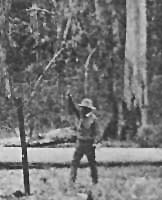 The enlargement detail in Burman photo 2 (Left) shows what could be seen as a post and rail fence on the slope, but in Burman photo No 1 (above),
they are saplings lying on the ground. It is entirely possible the long thin saplings may have been axed and dropped by prospectors for building purposes as the area looks as though it may have been cleared indicating human activity.
The enlargement detail in Burman photo 2 (Left) shows what could be seen as a post and rail fence on the slope, but in Burman photo No 1 (above),
they are saplings lying on the ground. It is entirely possible the long thin saplings may have been axed and dropped by prospectors for building purposes as the area looks as though it may have been cleared indicating human activity.
I noticed what looked like a fence,
perhaps an indication of human activity I thought.
To supplement this very scant information which I had gleaned from photographs and which I had shown to Gary Dean, we decided together to take a closer look at the actual area of bush where I thought this activity may have taken place. While there, Gary was scouting around the area when I stumbled onto a pile of large moss covered rocks and called out “Hey, Gary look at this”, when he came into view we both said, 'a fireplace'. On a return trip to the site a week later I found the second fireplace only 12 metres away.
 Gary
Dean, Bill and Carla Denheld at Stringybark Ck on the day we found the fireplace of the hut on the 5 Sept. 2002
Gary
Dean, Bill and Carla Denheld at Stringybark Ck on the day we found the fireplace of the hut on the 5 Sept. 2002
How the bush hut fireplaces were
found.
Read the full story,
< click here >
Story 5 A Kelly tree history.
The
Kelly tree is perhaps one famous trees in Australia, it attracts a lot of
visitors and is accompanied by a fitting memorial to the three policemen
who were killed here. Side by side, the iconic symbols of tragedy.
 |
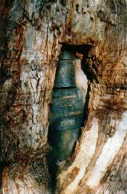 |
 |
above The Kelly tree . Centre, the iconic armour motif of the Kelly gang. Right, the Memorial stone at Stringybark Ck reserve, dedicated to the three policemen, two of whom left families behind, a point that often gets ignored.
The plaque reads ; In Memory of Sergeant Michael Kennedy No:2009. Constable Michael Scanlon No: 2118. Constable Thomas Lonigan No: 2423. Killed at Stringybark Creek on the 26th October, 1878 during the execution of their duty in a gunfight with a group of men later known as the “ Kelly Gang “ Respectfully remembered and never forgotten The Victorian Police Force Plaque unveiled by Michael and Mick Kennedy on the 26th of October, 2001.
As early as 1940, Kelly historians had problems visualizing the present day Kelly tree in its surroundings on the western bank of Stringybark Creek as the site of the shoot-out. The picture of the Kelly tree above is looking south east with the Creek on the left. The iconic armour motif is being swallowed up by the marked tree until one day the motif will disappear altogether. With
research continuing, we hope to confirm the true location of the police camp
following the finding of the two old fireplaces of two huts, one now wonders whether
alternative plans for future tourism need to be made considering the
key markers maybe some 3- 400 metres from the true site ?
I f you can add to the story email me - bill at denheldid
dot com
To see early photos and a history of the Kelly tree
< click here >
Story 6
McIntyre’s sketch and the Burman photographs compared.
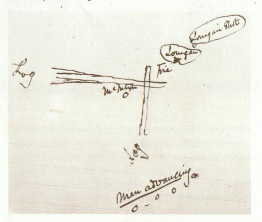 This sketch
left drawn by Constable McIntyre, the only surviving witness, (other than the four members of the gang) of the shoot-out, shows where Constable Lonigan was killed in relationship to
the fire at the crossed logs, and the point from where the gang advanced
into the camp. Constable McIntyre had made a written statement accompanied by this sketch and there is a note made, presumably when the sketch and the Burman photos of the re-enactments were presented at Ned Kelly's
preliminary trial almost two years later. The magistrate wrote on a piece of paper attached to the photo, saying;
This sketch
left drawn by Constable McIntyre, the only surviving witness, (other than the four members of the gang) of the shoot-out, shows where Constable Lonigan was killed in relationship to
the fire at the crossed logs, and the point from where the gang advanced
into the camp. Constable McIntyre had made a written statement accompanied by this sketch and there is a note made, presumably when the sketch and the Burman photos of the re-enactments were presented at Ned Kelly's
preliminary trial almost two years later. The magistrate wrote on a piece of paper attached to the photo, saying;
“ Doubts as to the accuracy of the scene (leading to reconstructions) perhaps been stimulated by a sense that this is a fairly unusual piece of evidence to Introduce”.
 This statement suggests that there was some confusion in assessing the evidence. The magistrate was shown a ‘post card’
( below) of the police murder scene, not a photo, but a ‘post card’ . Secondly, the magistrate compared the sketch by Cnst. McIntyre with the ‘post card’, and as can be seen, they are quite different. Shortly before his execution, Ned Kelly wrote a letter to the Governor of Victoria hoping to point out the injustices of his
case. In it, he asks the Governor to examine contradictions in McIntyre’s evidence suggesting the governor would at once see the disparity between the two versions, and using the photo Ned hopes to verify that they (the gang) were in a direct line when facing the two police at the camp - proving they did not ambush the returning police.
This statement suggests that there was some confusion in assessing the evidence. The magistrate was shown a ‘post card’
( below) of the police murder scene, not a photo, but a ‘post card’ . Secondly, the magistrate compared the sketch by Cnst. McIntyre with the ‘post card’, and as can be seen, they are quite different. Shortly before his execution, Ned Kelly wrote a letter to the Governor of Victoria hoping to point out the injustices of his
case. In it, he asks the Governor to examine contradictions in McIntyre’s evidence suggesting the governor would at once see the disparity between the two versions, and using the photo Ned hopes to verify that they (the gang) were in a direct line when facing the two police at the camp - proving they did not ambush the returning police.
Photo and sketch, reproduced with the permission of the Keeper of Public Records. Public Record Office Victoria, Australia'. Burman Photo1, citation No, VPRS 4966 Consignment P0 Unit 2 Item 30 Record 1 Document: Photo of Wombat Ranges where troopers were shot.
In this story we compare the sketch and the photos to reveal where the mix up may have occurred. We create a grid on the Burman photo to accurately construct a birds eye view of the scene based on both photos.
McIntyre’s sketch and the Burman photographs compared.
< click here >
Story
7
Blue Range, crucial to the Kelly story !

Blue Range as seen when leaving Mansfield on the way to Tolmie and Stringybark Ck.
It may be that Blue Range played a crucial role as to why the police went to Stringybark creek due to a letter received at police headquarters. This little known fact has been overlooked by many.
A plausible explanation hinges on the letter and map dated 18th Oct. 1878, by a writer who asks to remain anonymous. The letter dated just 8 days before the police shoot-out with the Kellys, advised that a cave situated at Blue Range could be occupied by the Kellys.
To find this cave, the writer gave instructions to draw a straight line on a map between Stringybark Ck on the east and Euroa in the west, and the cave would be found near where the line intersected Blue Range. The above picture of Blue range is the eastern end, and it stretches for miles, although the writer refers to the western end. With this information we now have an idea more than likely, as to where two of the four police party went on that first and fatal day.
 |
 |

Reproduced with the permission of the Keeper of Public Records. Public Record Office Victoria, Australia'. Citation No, VPRS 4969 Consignment P0 Unit 2 Item 72 Record 1 Document: Discovery of cave near Murchison possible hide-out and map, Map of Cave . |
While
the above letter does mention Stringybark Creek, I consider the letter to
be a trigger that set off a chain of events for the apprehension of the
Kellys.
Mansfield Guardian dated 16 Nov 1878 reported that 'Walter Lynch was with the Kelly party the night before the police were murdered and could give information as to who the unknown men are who are with the Kellys'.
( source, Sheila Hutchinson)
With the implication, of Lynch having intimate knowledge of the Kellys' at their Bullock Ck camp
hideout, we may wonder whether his former partners Bromfield or Reynolds also held that knowledge?.
In search for reasons why the
the police decided to camp at Stringybark Ck instead of anywhere else
(within the hundreds of square miles of the Wombat Ranges), we should ask the
question, ' did Percy Bromfield , Willy Reynolds, Walter Lynch, John Martin
or a Mr. Tolmie' or any one of those men notify the police of the Kelly's being at Bullock Ck.
Then, consider the Blue Range letter being sent only a week before the police
set out and in it suggesting the Kellys could be at
Blue Range not far from Stringybark Creek.
Sergeant. Kennedy (in charge of police station Mansfield) having an
optimistic view of a quick capture, together with the lure of a very
generous
reward monies offered to the police as well as members of the the public, the attempted capture of the
wanted Kellys began.
To show how close the two camps were, in the picture
below the aircraft wing strut is Stringybark
Ck. To the centre right is Kellys Ck and the horizontal ridge through the
middle from left to right is Ryan's CK and away from the viewer, the foot
hills of Blue Range can be seen at the very uppermost photo edge and is about 8 km away, an easy distance to cover by
mounted police camped at Stringybark Ck.
UPDATE: This cave has been found
pretty well as described and visited by Stephan and Mellisa
Hanbury and mates David and Debbie Hibbert, 27 July 2014
![]() fs-267_Kelly_Cave.pdf
fs-267_Kelly_Cave.pdf

Aerial view of both Stringybark and Kellys Creek
This view is looking S.
West.
For the full story, Blue Range, read the letter and see the map. < click here >
Story 8, The Bullets of Kellys Creek.

Including the only known photo of the actual trees fired at by the Kellys during their target practice, ( well before the shootings at Stringybark Ck ) I spotted this remarkable picture detail only very recently, Aug 2003.
< click here>
Story 9, The Kelly hut on Bullock Creek.
 This looks at the possibility there were two huts at Kellys Ck. One described by Constable James Nov 1878, the other by an unknown reporter of the Melbourne Argus Newspaper 1880. Another first is a photo found of the Kelly Ck sawmill that was constructed directly over the Kelly hut site in 1930. This picture reveals another target tree
that was identified to me by Billy Stewart in 1985, up till Jan 2004 it
was lying rotting in the creek. Recently it has been recovered for
preservation.
<click here>
This looks at the possibility there were two huts at Kellys Ck. One described by Constable James Nov 1878, the other by an unknown reporter of the Melbourne Argus Newspaper 1880. Another first is a photo found of the Kelly Ck sawmill that was constructed directly over the Kelly hut site in 1930. This picture reveals another target tree
that was identified to me by Billy Stewart in 1985, up till Jan 2004 it
was lying rotting in the creek. Recently it has been recovered for
preservation.
<click here>
Story 10, The EK marked gun.
This new page reports on other Kelly related items. The gun was found in a mine shaft at Beechworth 1940's together with three other muzzle loaders and are very old. They were probably part of the Kelly sympathizer armourment and dumped as the EK inscription may have become a liability to the owner.
Also New,
 see a picture of the possible Kelly campfire rocks as they were photographed by a Tolmie working party that visited The Kelly Camp some years later.
see a picture of the possible Kelly campfire rocks as they were photographed by a Tolmie working party that visited The Kelly Camp some years later.
<click here>
Story 11, The Stringybark Creek Investigation May
2009
Read how five historians investigate the true site of the police camp at
Stringybark Creek after 40 year believing it was on the Eastern bank of of
the creek. All indications are it was on the Western side of the creek.
<
Click Here >
Story 12,
Germans Creek where Sergeant Kennedy died
Time line for the Two Huts stories
The two huts stories are itemised in the following time line points.
For the purpose to separate source records = maroon from,
points of conjecture = blue from,
new information and recent discoveries = red please refer to this colour code below. (only applies to this timeline)
Please note, there were two huts at the Stringybark Creek police camp,
and we know of one or maybe two huts at the Bullock Creek (Kellys Ck), Kelly camp. Un be known to the police troopers, these camps were only 1 mile apart.
|
1850's, At Stringybark Creek, the original lease holders of Fern Hills Station, Messrs Heape and Grice build two huts. Sometime later the huts abandoned - were rebuild by unknown prospectors. These two huts, later to be occupied by Reynolds*, Bromfield and Lynch. We know at least one hut was shingle built, as Ned Kelly referred to Stringybark Creek as the Shingle hut in his Jerilderie letter in April 1879. Intro and Story 1 * Willy Reynolds lead the search party to Stringybark Creek on the 27th Oct 1878 (a little known fact), Willy was the son of the Dr. Samuel Reynolds (who carried out autopsies on the bodies of the dead police. Sgnt. Kennedy's body was not found till five days later some six hundred meters away, but no autopsy was carried out by the doctor, it was more an inspection to verify the fatal wounds. 1860's, At Bullock Creek, later known as Kellys Creek was also known by local prospectors as Boggy Creek). (Mansfield Guardian 8 March 1879), reported Ned Kelly and his brother worked for gold here and that Walter Lynch and Mr. P. Bromfield are said to have worked in the same vicinity. There was a log cabin style hut built here by a Canadian prospector years before which Dan and brother Jim fixed up. Intro, also Story 9. During May to July 1877 prospect party Reynolds, Bromfield and Lynch occupy the two huts at Stringybark Creek for three months. One hut was burnt down causing problems in the camp that leads to Bromfield building another Story 1 and Story 2 August 1877, Bromfield sues Lynch for burning down his new hut, but charges are dropped. Witness to the court hearing was Snr. Const. Kennedy, (later) Sergeant Kennedy, Having been witness, Kennedy would now have an idea where Stringybark Creek was situated. Intro page. April 1878, The Fitzpatrick affair, the ' wanted' Kellys go into hiding at Bullock Creek. Five months later, Sept 1878 boundary rider John Martin working for Mr. Tolmie laid dog bait close to the Kelly camp at Bullock Creek. At the time when the police found the Kelly camp, a tree nearby had been marked J.Martain. Who carved this name in is not known, but Ned later blamed Martin for the reason the police turned up at Stringybark Creek. Story 7. August 1878, Sgnt. Kennedy writes to Supt. Sadleir suggesting he could capture the Kellys using Stringybark Creek as a base but needed two more men. Story 7 Early October 1878 Sgnt. Kennedy asks a Mr. Tolmie to show him Stringybark Creek only two weeks before the police party set out. (Ewen Tolmie had 3 sons, all middle aged at the time, so there were 4 Mr. Tolmie's ) Story 7 October 18, 1878, Archive source PRoV, letter referring to Blue Range cave and Stringybark Creek sent to police and probably the trigger to mount the police party Kelly man hunt a week later on 25th Oct. Story 7 Oct. 25th 1878 Kellys find suspect police horse tracks. Note, prospector Walter Lynch who had occupied the huts at Stringybark Ck 15 months prior was reported to have been with the Kellys at their camp on the night of, 24th Oct.78
Oct. 25th. Gun shots heard at Kelly camp. Kellys find police camped at Stringybark Ck near the Shingle hut. Kellys take the initiative to take police camp or be shot.
Their plan goes horribly wrong, 3 police dead. October 26th, the Kelly gang leave the area, later to be proclaimed outlaws. November.1878 Photographers Burman take
what could be the first forensic style photos of the police 'murder' scene at Stringybark Ck. There is no indication in the records of exactly where the photos were taken. Careful examination of shadow details reveal the direction of North in the photo.
Orientation of the Burman photos.
Story 3
The Sketch by Constable McIntyre of the place is no more revealing. The photo and the sketch are compared to reveal serious problems of orientation. As a result, newspapers reporting on the tragedy create illustrated reports uses Burman's photo and McIntyre's sketch in combination.
This raises the question - are the views
printed back to front. Using illustration skills, the photos helped recreate a birds eye view of the police camp
reveal McIntyre's
sketch do not fit the Burman photo scene.
See Story 6 Nov 26th 1880 The Argus newspaper has a write up of visit to Kelly camp with a picture of a Kelly hut. My research proves that picture was printed back to front, also it was reported 1893 there were 'huts' there and only the ' fireplaces' could now be seen. (Note plural) indicating two huts. Story 9 1883 A cattle muster work party photograph Kelly camp prior to Ewen Tolmie's death in 1883. The work party photographed sites in the high country obviously f due to the novelty of a new
small camera. One photo was of the famous Kelly camp. The remains of a hut site can be seen, also the bullet holed target trees chopped by the Kellys to recover the lead are in
the background.
Story 8, 1884/5 the first goldfields map survey of the area shows a lone marked hut near the scene where the police shootout with the Kellys occurred.
See Story 2
1929 Writer J.J. Kenneally has the fifth member of the Kelly gang ' Tom Lloyd' as his guide when researching his book of 1929. ' The inner history of the Kelly Gang' states; when Ned asks McIntyre who is in the hut, I believe this has been re interpreted in subsequent publications to read 'who is in the tent. The possible reason, because until just recently, publishing historians had no proof of the location of the huts. Ned referred to the shingle hut because it was there, near where the police camped. See Intro page
1930's the ' Kelly camp' site was over built by
the McCashney Harper sawmill The sawmill owners had little regard for the Kellys or their camp
site although they did leave an old 'dead' tree standing that had been
used for target practice by the Kellys and had been chopped to
recover the bullet lead. The Kelly target tree was still
standing till late 1930's or 40's. During 1985,
Detecting for bullet lead at Kellys Creek. Find musket balls, and .45 cal cone bullets and some small calibre balls .31" possibly fired from a pistol. By co-incidence I meet Mr. Bill Stewart who showed me the Kelly camp site. Bill's father took visitors there at the turn of the century Bill remembered he was only 6 years being there, Later, he worked at the Kelly Ck sawmill till 1934 when it closed. This
meeting with Bill encouraged
me to write my story, The Bullets of Kellys Creek *,
Story 8 |
Notes
The name Scanlan is often spelt Scanlon. Most official documents have Scanlan including, his grave headstone, monument Mansfield town centre, The Royal Commission of 1881, J.J. Kenneally' s book of 1929 and his records in court cases of the time. Scanlon is recorded on the memorial at the Stringybark Ck reserve, in books, by Ian Jones, Keith McMenomy, Max Brown, Gary Dean and G. Wilson Hall to name a few. In this website I chose Scanlan.
* According to Public Records Office of Vic (PROV) Burman and Madeley was the company of photographers based on Bourke Street Melbourne.
The Mansfield Guardian dated 28 Nov. 1878 refers to Mr. Burman as selling the photos as advertised ( Sheila Hutchinson’s book, Heritage and History on My Doorstep)
** Apart from burning down Bromfield’s hut , Walter Lynch was a Kelly sympathizer who most likely occupied the huts prior to the events there and he wrote a threatening letter to a local Mr. Monk who apparently helped the police. Later, Lynch was prosecuted for his threats and served three years in gaol.
Mansfield Guardian dated 16 Nov 1878 reported that 'Walter Lynch was with the Kelly party the night before the police were murdered and could give information as to who the unknown men are who are with the Kellys'.(source, Sheila Hutchinson) With
this implication, of Lynch having intimate knowledge of the Kellys' at their Bullock Ck camp, we may wonder whether his former partners Bromfield and Reynolds also held that knowledge?.
The doctor who carried out the autopsy on the bodies of the three dead police was Dr Samuel Reynolds whose son
(Willy) William Reynolds was the first member of the prospecting party. Dr Samuel Reynolds came to Australia for gold prospects and became a miner that also practiced his chosen profession as doctor. It was probably the 'Doctors'
interest in gold prospecting that brought him to try in the Wombat Ranges area. He may even have had experience of the discovery
of gold deposits at S/Bark and Bullock Ck. Later he and his family settled in Mansfield
A book,
written by the Doctors great grand daughter Joan Gillison, 'Colonial Doctor and his town' makes mention of the doctors son 'Willy' being an excellent bushman who lead the police search party to Stringybark Ck at night the following day after the killings.
Publications
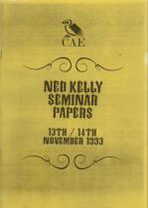 The Ned Kelly Seminar Papers "Ned Kelly: Man And
The Ned Kelly Seminar Papers "Ned Kelly: Man And
![]() Myth Revisited”
Myth Revisited”
The proceedings of the seminar held at Beechworth 13th and 14th Nov. 1993 were published by the Council of Adult Education (CAE). It featured eminent writers; Mr. Keith Mc. Menomy, Mr. Ian Jones, The Chief Justice of Victoria, His Honour John H. Phillips, Dr. John McQuilton, Jane Clark, and was edited by Marian Matta.
This publication, is not available through CAE, contact
me direct, E-mail bill at
denheldid dot com
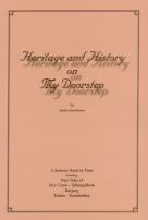 Another publication worth acquiring, is Heritage and History on My Doorstep. It is an excellent historical look at the districts of the Wombat Ranges, written by local historian Sheila Hutchinson. It covers the history of gold mining and gem fields of the district and reports snippets of interest relating to the ‘Kelly’ connections. Her father, Tim Brond, marked the present day
Kelly tree in 1933/4 by inscribing the three policemen’s names. Sheila grew up near Stringybark Creek and has been a valuable source of information and key photographs relating to my story .
Another publication worth acquiring, is Heritage and History on My Doorstep. It is an excellent historical look at the districts of the Wombat Ranges, written by local historian Sheila Hutchinson. It covers the history of gold mining and gem fields of the district and reports snippets of interest relating to the ‘Kelly’ connections. Her father, Tim Brond, marked the present day
Kelly tree in 1933/4 by inscribing the three policemen’s names. Sheila grew up near Stringybark Creek and has been a valuable source of information and key photographs relating to my story .
Copies of her book are available direct from Sheila.
email joshe at mansfield dot net dot
au
 In
2003 Mansfield Historical Society members
compiled a 20 page publication titled
Stringybark Creek and other stories
to
commemorate the 125th anniversary of the shootings at Stringybark Creek in
Oct 1878
.
In
2003 Mansfield Historical Society members
compiled a 20 page publication titled
Stringybark Creek and other stories
to
commemorate the 125th anniversary of the shootings at Stringybark Creek in
Oct 1878
.
It profiles the troopers involved in the Stringybark Creek tragedy and a
time line account of events
associated with it as reported in the
Mansfield Guardian newspaper at the time. The booklet is
available
direct;
Mansfield Historical Society Inc. P/O Box 309 Mansfield 3724 Vic
Australia. Cost $ 10 including postage.
Inquires welcome. email
mansfieldhs@iinet.net.au
The first Kelly book published, titled
THE KELLY GANG ‘The Outlaws of the Wombat ranges’
by G. Wilson Hall, the publisher and proprietor of the Mansfield Guardian.
This publication was in print while the gang had been on the run for six months. It is very rare with only three copies known to exist.
contact the State library of Victoria who have a transcript they are prepared to photocopy.
Otherwise
Contact
brianmac at isp dot net dot au
Note, E-mail from Brian McDonald, collector and author of 'Kellyana',
a booklet that lists a large number of published works to do with Kelly,
makes mention that the above transcript contains quite a few errors and
should not be relied upon. As well as many typographical and spelling
mistakes, there are two pages missing (seven paragraphs in all) from the
preface that give a more detailed explanation as to why G. W. Hall
published the work. For any serious research the original rare and
extremely detailed publication should be consulted. Thank you Brian.
Contact brianmac at isp dot net dot au for
his must have booklet.
___________________________________________________________________
Many thanks to
Marian Matta, for
locating a copy of the CAE Ned Kelly Seminar Papers 1993, helping with historical facts, and reading through various drafts.
Gary Dean , for his help in finding the fireplaces, for providing historical reports, field survey and excavation at the site.
Ian Jones for providing his excellent insight into Stringybark Ck, contained in the Ned Kelly Seminar Papers of 1993.
Sheila Hutchinson for her book and providing her knowledge and pictures of the Kelly tree, via her friend Charlie Engelke of WA.
Peter Free, of The Police Historical Unit for their permission to show the Burman photos and Constable McIntyre’s sketch.
James McKinnon, The Keeper of Public records of Victoria ( PROV) for permission to show historical documents in support of my story.
The State Library of Victoria for extract from Jerilderie letter’ and who, according to PROV is believed to hold some of the images of the Burman photo Kelly series. ?
David Hurley and Terry Kingston of Parks Victoria in support of activities at the site.
Tim Pollock, Doug Anderson, Geoff Hearn, for the numerous proof readings and corrections.
Arthur Francis for his overview and constructive critique.
Carla my wife for her forbearance and patience during this work.
All photos from private and public collections, many thanks.
EK branding iron impression was Edward Kelly's own brand.
|
STATEMENT: This website does not glorify
bushrangers, criminals or denigrate officers of
the law, it simply presents the facts as reported
at the time. Also, it is not possible to present
theories without an element of 'conjecture', for
accepted history may one day be found to be not
quite right. It is therefore the duty of all
historians to ask questions, and hopefully
'sometimes' find answers. This work is purely a quest to find truth and balance and share the knowledge. Mistakes may be made along the way for you to pickup on, so please feel free to add to the story by contacting the webmaster. |
The
writer reserves copyright and none of the text or images may be
commercially reproduced without written
permission. Some personal views expressed are conjecture - based
upon published works and open to feedback to Bill
Denheld. E-mail bill at denheldid dot com
Oct. 2002
Site created
25.2.03 revised *15 June 2005 add time line note Heape and
Grice
*11 March 2006 - A problem to solve. Re edited subject to new informations
being added to May 2009,
This background image is of the Kelly camp at Bullock Creek photographed
during a station work party prior to 1883. The remains of the Kelly fortified
hut.




